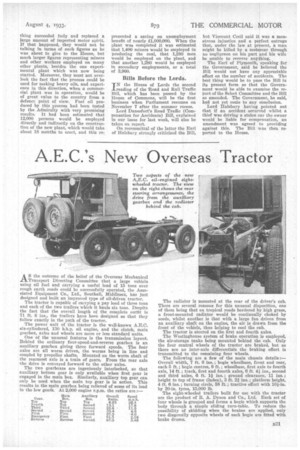A.E.C.'s New Overseas Tractor
Page 31

If you've noticed an error in this article please click here to report it so we can fix it.
AS the outcome of the belief of the Overseas Mechanical Transport Directing Committee that a large vehicle using oil fuel and carrying a useful load of 15 tons over rough earth roads could be successfully operated, the Associated Equipment Co., Ltd., Southall, Middlesex, has just designed and built an improved type of oil-driven tractor.
The tractor is capable of carrying a pay load of three tons and each of the two trailers which it hauls six tons. Despite the fact that the overall length of the complete outfit is 71 ft. 8 ins., the trailers have been designed so that they follow exactly in the path of the tractor.
The power unit of the tractor is the well-known A.E.C. six-cylindered, 130 b.h.p. oil engine, and the clutch, main gearbox, axles and wheels are more or less standard units.
One of the unusual features is the transmission layout. Behind the ordinary four-speed-and-reverse gearbox is an auxiliary gearbox giving three forward speeds. The four axles are all worm driven, the worms being in line and coupled by propeller shafts. Mounted on the worm shaft of the rearmost axle is a train of gears. From the rear axle the drive is conveyed forward to the other axles.
The two gearboxes are ingeniously interlocked, so that auxiliary bottom gear is only available when first gear is engaged in the main box. Similarly, auxiliary top gear can only be used when the main top gear is in action. This results in the main gearbox being relieved of some of its load in the low gears. At 2,000 engine r.p.m. the ratios are : The radiator is mounted at the rear of the driver's cab. There are several reasons for this unusual disposition, one of them being that on tropical roads bordered by high grass, a front-mounted radiator would be continually choked by seeds, whilst another is that with a large fan driven from an auxiliary shaft on the engine, the air is drawn from the front of the vehicle, thus helping to cool the cab.
The tractor is steered on the first and fourth axles.
The Westinghouse system of brake operation is employed, the air-storage tanks being mounted behind the cab. Only the four central wheels of the tractor are braked, but as there are no inter-axle differentials the braking effort is transmitted to the remaining four wheels.
The following are a few of the main chassis details:— Overall width, 7 ft. 6 ins.; bogie wheelbase, front and rear, each 5 ft.' bogie centres, 9 ft.; wheelbase, first axle to fourth axle, 14 ft. ; track, first and fourth axles' 6 ft. 4i ins. second and third axles, 6 ft. 11 ins.; ground clearance, 11 ins. ; height to top of frame (laden), 3 ft. 21 ins.; platform height, 4 ft. 6 ins.; turning circle, 58 ft.; tractive effort with 10i-in. by 20-in. tyres, 15,000 lb.
The eight-wheeled trailers built for use with the tractor are the product of R. A. Dyson and Co., Ltd. Each set of four wheels is grouped and forms a bogie which supports the body through a simple sliding turn-table. To reduce the possibility of skidding when the brakes are applied, only two diagonally opposite wheels of each bogie are fitted with brake drums.




















































































